If I Have a Kid Would Tuat Make My Uncle the Babys Grate Uncle
– I am your father's brother's nephew's cousin's former roommate.
– What does that make u.s.?
– Absolutely nothing!
(Lord Dark Helmet and Lone Starr, discussing family relationships in the Mel Brooks motion-picture show Spaceballs.)
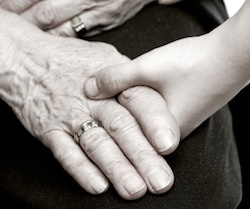
Why is your great-grandmother great?
Keeping runway of family relations can be difficult. If Edna marries your female parent's uncle Charlie, what should you call her? If your father's cousin's girl just had a infant boy, how should you two exist introduced? Who is your "great bang-up aunt", and how can y'all find your "first cousin twice removed"? Fortunately, a bit of mathematical logic can clarify who should exist called what, and why – and even measure the degree of genetic similarity between different relatives.
Ancestor Lineage
To begin at the beginning (well, your commencement, anyhow), you surely had 2 parents, a mother and male parent:

Continuing backwards, they each had 2 parents, giving you a total of four grandparents:
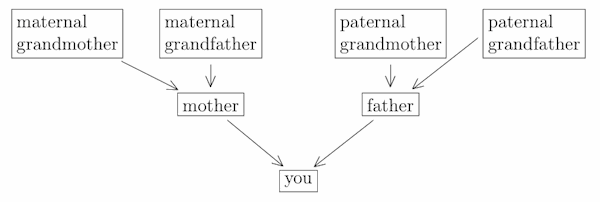
Going back still further, each of your ancestors in plow had two parents, indicated past prepending an actress "great" each time. For example, your maternal lineage is:
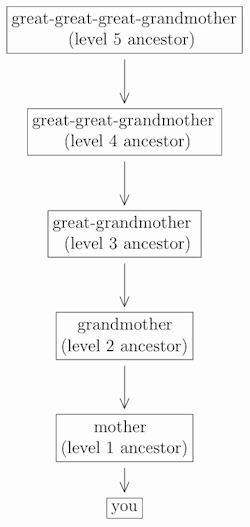
and and so on (and similarly for "fathers" instead of "mothers" at any level).
Since each antecedent has two parents (1 mother and one father), you have a total of 2n ancestors at level n: two parents, iv grandparents, eight corking-grandparents, sixteen great-great-grandparents, and then on. Summing up, you have a total of 2+22 +ii3 +...+ii n =2 n+one − two ancestors of level n or lower; for instance, your total number of parents and grandparents and groovy-grandparents combined is iiiii+1 − 2 = 16 − 2 = 14. In short, your ancestors course a perfect binary tree – simplicity itself.
Descendant legacy
If yous have children yourself, then their children are your grandchildren, and your grand-children'southward children are your cracking-grandchildren, and so on:
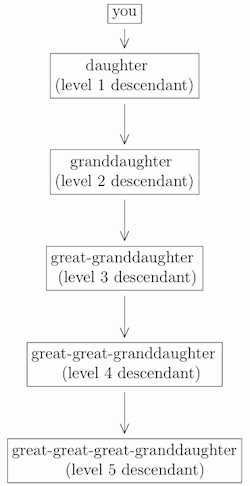
(and similarly for "son" instead of "daughter" at any level).
Unlike with ancestors, there is no simple formula for your number of descendants. Rather, you accept to count up all of your children, and all of their children, and so on. For example, even if you have five children, it is possible that none of them will have children of their own, in which instance your number of grandchildren will exist aught. On the other mitt, if they each have five children of their own, then you will have 20-five grandchildren – a lot more.
Sideways, march!
When people take more than than one child, this fattens the family tree, creating new relationships like sister and niece and great-aunt and more. For starters, if your parents have additional children besides you, then they are of course your siblings, that is your sisters and brothers:
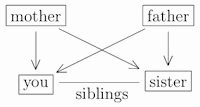
(Here, and throughout, relationships to "you" are written within the boxes, and relationships between other pairs of individuals are indicated by connecting lines.)
If you and your siblings each take children, then those children are first-cousins of each other. And so, if the ii get-go-cousins each take children, then those children are second-cousins of each other; and their children are third-cousins, and then on:
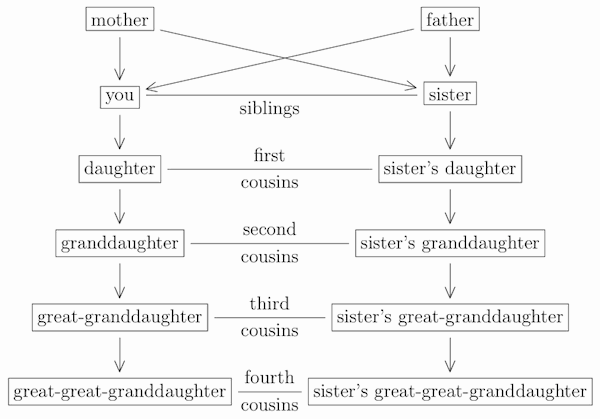
(and similarly for "son" instead of "daughter" at whatsoever level).
In general, n-level cousins share two (n + i)-level ancestors (but no north-level ancestors). Thus, kickoff-cousins share two grandparents (but no parents), and 2nd-cousins share 2 great-grandparents (just no grandparents), and then on.
It follows that if A and B are due north-level cousins, then A'due south kid and B's child are (north+one)-level cousins. Thus, children of first-cousins are 2nd-cousins, and children of second-cousins are third-cousins, and and so on. In fact, if we regard siblings as 0-level cousins, then this reasoning applies to siblings too: children of 0-level cousins (ie, siblings) are themselves first-cousins.
Finally, your sibling'southward child is your niece (or nephew, if male person), and their kid is your great-niece (or great-nephew), and then on:
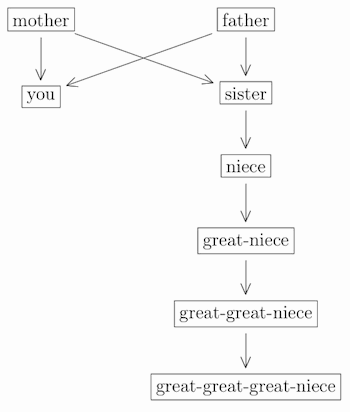
(and similarly for "nephew" instead of "niece" at any level).
Cry Uncle
So now we know where your descendants' cousins come from. To see where your cousins come from, we have to motion upward to your parents' level. Your parents' siblings are your aunts and uncles, and their children are your first-cousins (since you lot and they share the aforementioned grandparents, but not the aforementioned parents):
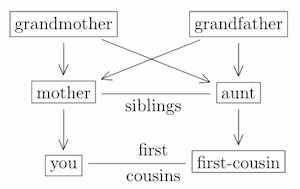
If your cousins have children, then what are they to yous? Well, children of your outset-cousin are called your "first-cousins-one time-removed", and their children are your "first-cousins-twice-removed", and then on:

To run into where your second-cousins come from, we accept to move 1 more level up. Your grandparents' siblings are your great-aunts and peachy-uncles. And then their children (ie, your parents' cousins) are your first-cousins-once-removed. And their children are your 2nd-cousins:
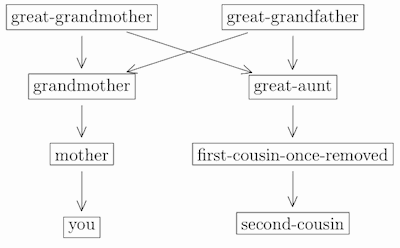
The aforementioned blueprint continues upwards for all earlier generations. In one case over again, your north th cousins share your (n + i)-level ancestors, only not your north th-level ancestors. Siblings of your north th-level ancestors are your great-...-dandy aunts and great-...-nifty uncles, where "slap-up" is repeated n − 1 times. Furthermore, the n th cousins of your m thursday-level ancestors, and also the k th-level descendants of your n thursday cousins, are your n thursday cousins thousand times removed.
For example, with n = 3 and k = two, this says that your grandparents' 3rd-cousins are your third-cousins-twice-removed, and your third-cousins' grandchildren are also your third-cousins-twice-removed. Tracing dorsum to n = three gives:

In this diagram, your third-cousin (due north = 3) shares ii of your great-great-grandparents (level n + 1 = 4 ancestors) but none of your peachy-grandparents (level n = 3 ancestors). Your great-cracking-aunt is a sibling of your neat-grandmother (n = three). Your 2nd-cousin-in one case-removed achieved that designation past being the second cousin (n = 2) of your mother (level thousand = 1 ancestor), while your third-cousin-one time-removed achieved that designation past being the daughter (level g = 1 descendant) of your third cousin (due north = 3). Catchy!
Thicker than h2o
One of the reasons we care about family copse is because of a sense that sure family unit relations are "more related" to us, and should be assisted and protected and loved on that basis. This attitude presumably has an evolutionary basis: our genes survived through the ages because our ancestors made efforts to help them survive past caring not only for themselves, simply for their close relatives likewise. Indeed, in that location is an aboriginal Bedouin Arab proverb, "I against my blood brother, my brothers and me against my cousins, then my cousins and I against strangers", which nicely illustrates the philosophy of caring most for those who are genetically closest to us.
This raises the question of just how similar our relatives' genes are to our own. Well, first of all, about 99.9% of our genetic material is mutual to all humans (yeah, even your in-laws), and indeed is what makes us man. Furthermore, some people may share other genes with us just past take a chance; for instance, if I encounter a stranger whose eyes are brown just like mine are, that does not necessarily establish that nosotros are close relatives. In add-on, there is lots of randomness in how genes are passed on (each individual gets one-half of their genetic material from their female parent and half from their father, but which $.25 come up from which parent is chosen at random and cannot be predicted), then nosotros cannot depict precise conclusions with certainty.
To bargain with all of this, we assign to each pair of individuals a relatedness coefficient which represents the expected fraction (ie, the fraction on average) of their genes which are forced to be identical by virtue of their family relationship. This approach averages out all of the randomness, while focusing on genetic similarities specifically due to family connections.
According to this definition, strangers have a relatedness of aught (the smallest possible value). By contrast, your relatedness with yourself is ane (the largest possible value). Other relatedness coefficients fall between these two extremes. For example, your relatedness with your female parent is one/2, since you obtain one-half of your genetic material from her. And your relatedness with your begetter is also 1/ii. By the same reasoning, your relatedness with your child is once again 1/2. Then far so good:

Next consider your maternal grandmother. She gave half of her genes to your female parent, and then your female parent gave half of her genes to you. It is possible that the one-half you took is exactly the same as the half your grandmother gave. It is also possible that the half yous took has no overlap at all with the half your grandmother gave. But on average, that is, in expectation, exactly half of the genetic material you took from your mother originated from your maternal grandmother. So, your relatedness coefficient with your grandmother is one-half of half, that is, (1/2) × (ane/two), or 1/iv:
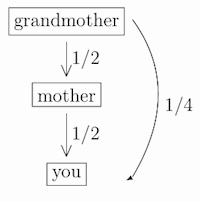
Continuing upwards the tree, your relatedness with your great-grandmother is one-one-half of one-half of one-half, that is: (1/2) × (1/2) × (1/2), or 1/8:
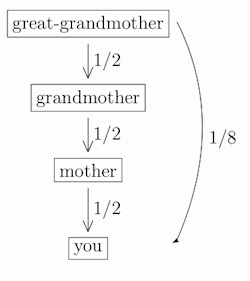
(and similarly for "begetter" instead of "female parent" at any level). In general, your relatedness coefficient with your level-north ancestor is 1/2 north .
By the same reasoning, your relatedness coefficient with your level-n descendant is likewise one/two n . So, for case, your relatedness coefficient with your daughter is 1/2; with your granddaughter is ane/4; and with your great-granddaughter is 1/8 (and similarly for "son" instead of "daughter").
For siblings, the situation is a little fleck more complex. Consider first the case of two half-siblings (one-half-sisters or one-half-brothers), that is, people who share simply one parent. Since they each got half of their genetic material from that 1 shared parent, their relatedness coefficient is one-half of one-half, that is 1/4:
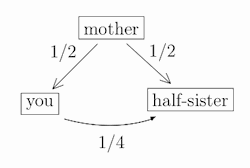
Regular (full) siblings similarly share 1/4 of their genetic material through their mother, but as well share 1/4 of their genetic material through their father. This gives a full relatedness coefficient of 1/iv + 1/4 = 1/ii:
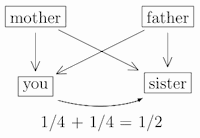
(One special case is identical twins, who have identical genes and thus a relatedness coefficient of ane. But fraternal twins have relatedness coefficient 1/two, just like other siblings.)
Continuing onward, since your mother and aunt are siblings, they have relatedness coefficient 1/2. Meanwhile, you and your mother have relatedness coefficient 1/ii. Putting this together, you and your aunt (or uncle) have relatedness coefficient (1/2) × (1/2) = 1/4:
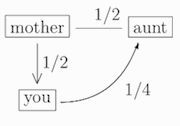
(and similarly with "aunt" replaced by "uncle"). And, your relatedness coefficient with your niece or nephew is also one/4.
And so, since your first-cousin has relatedness coefficient one/2 with your aunt, who in turn has relatedness coefficient 1/iv with you, information technology follows that you and your kickoff-cousin share relatedness coefficient 1/8:
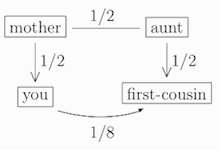
Now, since your mother and her first-cousin have relatedness coefficient one/viii, and since you have relatedness coefficient 1/two with your mother, and since your female parent'southward first-cousin has relatedness coefficient 1/two with her ain child (who is your second-cousin), it follows that your relatedness coefficient with your 2d-cousin is (1/2) × (1/8) × (i/two) = 1/32:
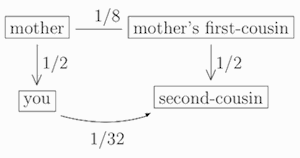
In full general, switching to level-n cousins from level-(northward − 1) cousins introduces two new factors of 1/2. Since (one/ii) × (1/2) = 1/four, this means that your relatedness coefficient with your level-northward cousin is always ane/4 times your relatedness coefficient with your level-(due north − 1) cousin. Information technology follows that your relatedness coefficient with your level-n cousin is equal to ane/2twonorth+one.
So, your relatedness coefficient with your first cousin is 1/8; with your second cousin is ane/32; with your tertiary cousin is ane/128; so on.
What about kickoff-cousins-one time-removed, and all of that? Well, since you and your first- cousin accept relatedness ane/8, and since your first-cousin and their child (your kickoff-cousin- once-removed) have relatedness 1/2, it follows that you lot and your first-cousin-once-removed have relatedness coefficient (i/viii) × (i/ii) = one/16:
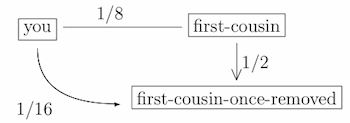
The blueprint continues, with each new "removed" introducing an extra factor of ane/two into the product. Information technology follows that your relatedness coefficient with your nth cousin, m times removed, is equal to ane/22n+grand+1. For example, your relatedness coefficient with your third cousin (due north = 3) twice removed (m = 2) is equal to 1/two6+ii+1 = ane/29 = 1/512 – not very close at all.
We can summarise the relatedness coefficients of various relationships in a table:
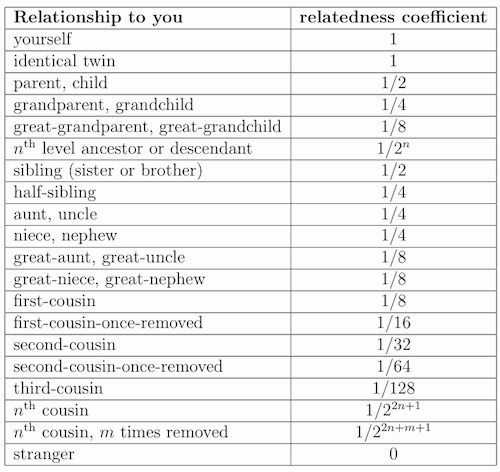
This table can be thought of as indicating your level of evolutionary imperative to protect and assist your diverse relatives. That perspective was nicely summarised past the early evolutionary biologist J.B.S. Haldane, when he was asked if he would requite his life to salvage a drowning brother, and replied "No, but I would to save ii brothers or eight cousins." He was merely observing that 2 × (i/two) = eight × (i/8) = 1, i.eastward. that ii brothers, or eight cousins, are each "equal" (in evolutionary terms) to ane re-create of yourself.
So what nigh that saying, "I against my brother, my brothers and me against my cousins, then my cousins and I against strangers"? Well, in the context of relatedness coefficients, it corresponds to the observation that your relatedness coefficient is higher with yourself (1) than with your brother (ane/two), college with your brother (1/two) than with your kickoff-cousin (one/8), and higher with your starting time-cousin (1/eight) than with a stranger (0). That is:
1 > 1/2 > 1/8 > 0.
It seems that those Bedouins knew their inequalities well!
Families of all shapes and sizes
Of course, the evolutionary imperative associated with relatedness coefficients does not tell the whole story. You would (hopefully) protect your spouse over your 2d-cousin fifty-fifty though, strictly speaking, your relatedness coefficient with your spouse is zero (since you have no actual blood human relationship). And, parents of adopted children should surely treat them just similar biological children, despite the lack of true genetic connection.
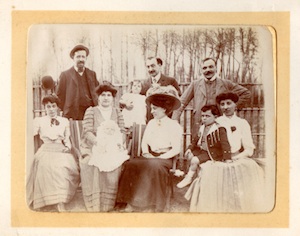
Other family relationships can arise also. For example, if you marry, and then your spouse'south relations go your corresponding in-constabulary relations – your husband'due south father is your father- in-constabulary, your husband's cousin is your cousin-in-police, and so on. The suffix "in-law" is also used for those who marry your relations – for example, your brother'due south wife is your sister-in- law. (One exception is that your aunt's married man gets to be chosen your uncle, even though he is "really" your uncle-in-constabulary; and similarly your uncle's wife gets to be called your aunt.)
Meanwhile, a woman who marries your male parent after your female parent becomes your step-mother (or footstep-male parent, if the genders are reversed). Her relations become your corresponding step-relations – your begetter'southward second wife'south brother is your stride-uncle, and his children are your pace-cousins, and so on. Of course, your genetic relatedness coefficient with your in-laws and your step-relations is aught, since your human relationship is through matrimony rather than bodily claret lines.
Family unit relations tin lead to unexpected surprises. At a recent large family reunion, I met a beau whom I did non know. After some give-and-take, nosotros adamant that my great-grandpa was the brother of his groovy-grandmother – making us third cousins. Furthermore, my great-grandmother was the sis of his great-granddad, too. That is, iii generations earlier, a brother-and-sister pair had married off with a sister-and-brother pair. This meant that he and I were tertiary-cousins past each of two different paths – we were "double third-cousins"! It followed that our relatedness coefficient was twice that of usual third-cousins – that is, equal to 2 × (1/128) = 1/64 – notwithstanding not very shut, simply interesting nonetheless. I wish I had had the presence of heed to immediately say to him, "Pleased to meet you, double-3rd-cousin. I am honoured to share one sixty-fourth of your genes."
About the author
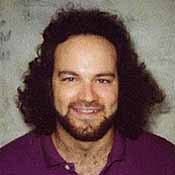
Jeffrey Southward. Rosenthal is a professor in the Section of Statistics at the Academy of Toronto, and the author of the popular book Struck past Lightning: The Curious Earth of Probabilities.
If I Have a Kid Would Tuat Make My Uncle the Babys Grate Uncle
Source: https://plus.maths.org/content/mathematics-your-next-family-reunion
0 Response to "If I Have a Kid Would Tuat Make My Uncle the Babys Grate Uncle"
Post a Comment